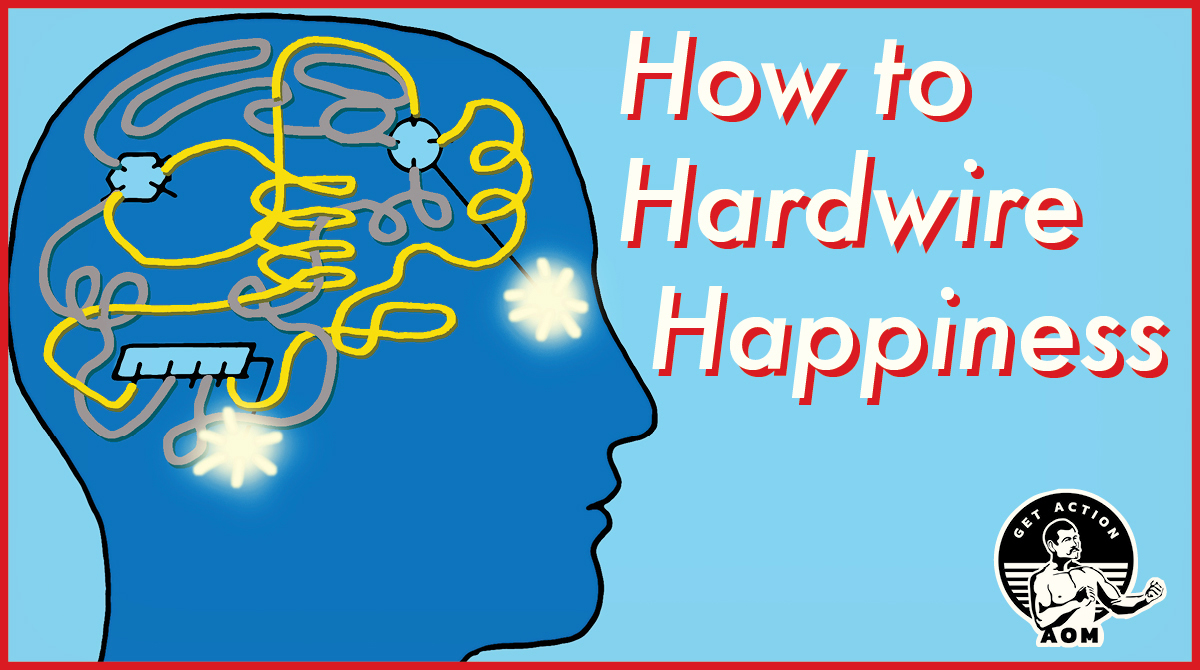If you’ve been reading/listening to AoM long enough, you likely know I describe myself as having a melancholic, Eeyore-like temperament.
While I think those who know me would say I’m a generally friendly, good humored and hearted fella who has his stuff together, I also have a tendency to focus on the negative, think in worst-case-scenarios, and look at life with a jaded lens. In times of significant stress, my low-level negativity can turn into a full-on depressive episode. Even in ordinary times, my moods can be mercurial: one week I’m feeling great, and another I spiral into a funk.
My wife and kids unfortunately feel the brunt of these bad moods. Kate says it feels like a dark storm cloud has descended on our household, and I’m just not pleasant to be around. My kids ask, “Why are you so grumpy, Dad?” The fact that I’m making my family feel bad, of course makes me feel bad, which further sucks me into Eeyore-dom.
I’ve gotten a better handle on my melancholic temperament in the past few years thanks to learning the best ways to manage depression.
But there’s been one thing that I started doing in the last couple years that has had a particularly strong impact on alleviating my depressive moods and helping me be more consistently positive.
In fact, and I don’t say this lightly, it’s been life-changing.
Every day for the past year I’ve been “rewiring” my brain for happiness with a simple meditative practice I learned from a psychologist named Rick Hanson. It’s so easy, you can do it in just a few seconds. Really.
Intrigued?
Keep reading.
Why Your Brain Is Wired for Negativity
Have you noticed that when things are going great, it hardly registers, but as soon as something bad happens, it sticks out like a sore thumb?
You know how it goes: your boss praises your work all the time, but he shoots down one idea, and that’s all you can think about; you start wondering if you even want to stay in that job. Or you post a pic on Instagram, and all your friends and family give you accolades and first bump emojis . . . but one person says something negative, and all the positive affirmation goes out the window. You’re still stewing about the snide remark hours later.
Why do our brains do this?
The human mind is designed with a negativity bias — we pay more attention and give more weight to negative experiences than positive ones. There’s likely a perfectly good evolutionary reason for this: increased sensitivity to potentially negative stimuli is what kept our caveman ancestors safe from life-threatening risks. It paid to be a bit paranoid and neurotic when a rustle in the leaves could mean a man-eating tiger.
All of us have inherited this negativity bias from our ancestors in varying degrees, and it’s still sometimes useful; while death no longer stalks us at every turn, there remain things in life that can definitely kill or maim you, or just be psychologically damaging, and being able to recognize and avoid them is important.
In some circumstances, though, our ingrained negativity bias is mismatched with the modern landscape; we lend an insult on social media the kind of attention commensurate with a life-and-death situation — as if we’re in danger of being ostracized from the protection of our ancestral tribe — when it actually has no real significance.
For some of us too, this negativity bias is simply too strong and too sensitive — it routinely gets activated by problems that don’t have meaningful consequences, crowds out the recognition of the positive things that are also going on, and causes rumination and emotional disturbance disproportionate to the trigger. In such cases, one’s negativity bias can lead to stress, depressive moods, and even full-on clinical depression.
For folks like us, our overactive negativity bias needs to be brought into healthy balance.
How do you do that?
Enter Rick Hanson.
According to Dr. Hanson, depressive people have brains that are like Velcro for the negative and Teflon for the positive; they glom on to the bad stuff, while letting the good stuff slide past.
To create a more positive brain, you’ve got to flip the equation — where you’re noticing the bad less, and, more importantly, allowing the good to really stick.
It takes deliberate intention to rewire your brain in this way, because while negative events will kick down the door of our consciousness, positive experiences have to be invited and ushered in.
This intentionality is created through a process that Hanson calls HEAL.
How to Hardwire Your Brain for Happiness with HEAL
HEAL is an acronym for:
Have a positive experience
Enrich it
Absorb it
Link it
In a nutshell, the HEAL process is all about proactively savoring positive experiences and emotions. By doing so, you train the brain to see more of the positive and less of the negative in life.
Here’s how to implement the HEAL process:
Have a positive experience. You don’t necessarily have to go out of your way to do this; oftentimes it’s simply a matter of noticing the good stuff that already happens throughout your day. For example, if my daughter runs up to give me a big hug, I make a point of recognizing what a nice moment it is. Or it could just be a matter of noting how great your warm mug feels in your hand and how good your coffee tastes as you drink it. Be on the lookout for nice sunsets, warm breezes, and other people’s acts of kindness.
If there aren’t any positive experiences happening to you at the moment (like if you’re commuting to work), you can create one in your mind. Think about a positive memory — a good time from the past, a goal you achieved, or someone you know who loves you. If you have a tendency to get down on yourself, try to think of aspects of character/personality that you like. Are you disciplined? Reliable? Reflect on those good qualities. You can even think about the fact that you’re alive and breathing and have a roof over your head. Those are definite positives, but our negative brain takes them for granted.
Really focus on the emotions that you feel when you think of these positive gifts and experiences. Do you feel proud? Grateful? Compassionate? Loved? Calm? Peaceful? Safe? Really feel those positive emotions. This focus on the emotional rewards of positive experiences is the key to rewiring your brain for happiness.
Enrich it. Remember, people with a strong negativity bias let the good stuff of life quickly slide off their brain like Teflon; it’s “Yup, there’s a sunset,” and their thoughts are immediately on to something else. The next two steps in the HEAL process are thus designed to get life’s positive vibes to stick in your mind like Velcro.
Once you have a positive experience, stay with it for five to ten seconds or longer. Enrich it by looking at it from different perspectives. Capture the moment in 3D. What’s going on around you? How does it feel in your body to experience that positive emotion? Imagine that feeling filling your mind. When you feel the positive emotion start fading, consciously bring it back and linger on it a bit more. The point of the enriching step is to rekindle that positive emotion over and over again; we’re trying to repeatedly fire those neurons connected to your positive feelings in order to create a new connection — a new more positive groove in your brain.
Absorb it. After you’ve enriched the positive feeling or experience, enhance its stickiness even further by imagining it sinking into your mind. Hanson recommends picturing those positive emotions soaking into your brain like a sponge. Author Laura Vanderkam suggests another way to absorb positive vibes: imagine that you have a treasure chest in your mind and that you’re stashing the good experience inside of it.
Link positive and negative material. Linking is kind of a weird step and one that I don’t personally use too often. Dr. Hanson even says it’s optional. It involves connecting the positive emotions/experiences that you’ve enriched and absorbed with a negative emotion or experience and then gradually imagining the positive overtaking the negative.
For example, let’s say you recently lost your job and you’re feeling down in the dumps. Bring that to your attention, but sort of hold it off to the side. Now, bring to mind a positive experience or reality like the fact that your family loves you. Enrich that feeling. Absorb it. Now imagine that positive feeling overtaking the negative emotions of you losing your job. What I do when I do practice linking is imagine my positive experience as a green blob swallowing up the red blob of a negative experience.
If all you can remember from this HEAL process is to intentionally take a few extra seconds to soak in good, joy-producing experiences like a sponge, you’ll be well on your way to pointing your brain in a more positive direction.
When to Hardwire Your Brain for Happiness
So that’s how you HEAL your way to a more positive mindset. But the trick is to do it regularly. It’s not a one and done thing. According to Dr. Hanson, what we’re trying to do is to create new neurological connections geared towards positive emotions, and to do that, you have do this HEAL process over and over again.
There are two ways you can do this:
In dedicated meditative sessions. You can set aside 10-30 minute chunks of time each day that you dedicate to doing this HEAL meditation. You can make your way through the process above on your own, or, if you need a little more structure/prompting, and want Dr. Hanson to walk you through the process, you can use the guided meditations he provides on his paid membership website, The Foundations of Well-Being. I’ve been following his guided meditations there for the past two years and have found them extremely helpful. I try to do one of these meditations at least once a day. They last anywhere from 20 to 30 minutes. I also do my own meditations whenever I have a longer drive somewhere; I just turn off the music and do a HEAL reflection about something positive. I think of these dedicated sessions as gym time for my mind to strengthen its positive networks.
Throughout the day as you have good experiences. In addition to the dedicated HEAL sessions, Hanson also recommends incorporating HEAL throughout your day as you have positive experiences. This is tricky because it requires you to be mindful of these moments, even though our brain has a tendency to overlook them. It requires you to be intentional; you have to make it a goal to notice positive experiences and then to enrich and absorb them.
Now when my kids run to give me a hug, I really savor it. I think about what it feels like to have their little arms wrapped around my neck, what they smell like, what my house looks like, what the weather outside is like. I’m basically trying to turn it into a very real, movie-esque memory. And then I soak the experience into my mind like water soaking into a sponge. I let the warm feeling wash over me. That hug becomes a part of who I am.
Another thought experiment that has helped me soak in the good is to imagine I’m an old man, and my kids are gone. What sorts of memories would that old me want? Present day me focuses on trying to store those memories away for future Brett. So as I go throughout my day, I’m looking for good memories that future me will want to savor. It’s like how Frederick the mouse spent the summer storing up colors and words for the winter (remember that book?). It’s weird, but it surprisingly works.
What Do You Want More? Not To Feel Silly or Not To Feel Miserable?
Now I’ll shoot straight with you. I know this HEAL thing seems pretty woo-wooey and touchy-feely. I was pretty apprehensive about it when I first started doing it in gusto because it just made me feel ridiculous. I also sometimes felt frustrated that I had to work so diligently at something that comes naturally for a lot of people. But, I was tired of being a cynical, jaded, depressed Eeyore that brought my family down, and I knew that the benefits of having a positive mindset to both body and mind are truly staggering, so I kept at it despite feeling like a cheeseball sometimes.
I’m glad I did because the difference has been night and day. A few weeks into regularly doing the meditation practices on the Foundations of Well-Being, and doing the HEAL thing during my day-to-day life, Kate, who didn’t even know what I was up to, noted that I just seemed a lot calmer and happier — that my whole aura was palpably different. And recently she said that in the two years that I’ve been regularly doing this HEAL stuff, I’ve had fewer funks and depressive setbacks. Plus, she just appreciates that I’m doing something to proactively tackle one of my issues; that’s the real secret of marital happiness — you never have to become perfect or completely overcome your problem, your spouse just wants you to acknowledge the issue and see that you’re earnestly trying to work on it.
If you’re tired of feeling miserable, I highly recommend giving HEAL a shot. It doesn’t take much time, and you don’t even have to spend money to do it (while I like Hanson’s guided meditations, you can definitely do this on your own). You’ve got nothing to lose except for your negative bias.
I do recommend picking up a copy of Hardwiring Happiness so you can get more details and insights about how to implement the HEAL process, and/or listening to my podcast with Dr. Hanson from a few years back:








